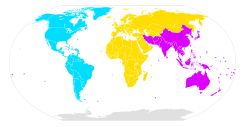9-centimeter band
The 9-centimeter band is a portion of the SHF (microwave) radio spectrum internationally allocated to amateur radio and amateur satellite use. The amateur radio band, in ITU regions 1 and 2, is between 3,300 MHz and 3,500 MHz, and it is available only on a secondary basis. The amateur satellite band is between 3,400 MHz and 3,410 MHz, and it is only available in ITU Regions 1 and 2, on a non-interference basis to other users (ITU footnote 5.282). In Germany and Israel, the band 3,400 - 3,475 MHz is also allocated to the amateur service on a secondary basis (ITU footnote 5.431).[1]
In CEPT's "European Common Allocation Table", footnote EU17 allocates 3,400 MHz to 3,410 MHz to European amateurs on a secondary basis.[2][3]
List of notable frequencies

- 3,400.1 MHz IARU Region-1 Calling frequency[3] and Global EME center of activity[3][4]
- 3,456.1 MHz IARU Region 2 Calling Frequency[4]
Radio Astronomy
3,332 - 3,339 MHz and 3345.8 - 3352.5 MHz are used by radio astronomers for spectral line observations.[4] Amateur stations voluntarily avoid using these frequencies when in geographic proximity to a radio telescope. ITU footnote 5.149 encourages all radio communications in the band to take practical steps to avoid harmful interference to radio astronomy observations in those frequency ranges.[1]
See also
Amateur radio frequency allocations
References
- 1 2 "FCC Online Table of Frequency Allocations" (PDF). 47 C.F.R. Federal Communications Commission. August 13, 2015. Retrieved October 27, 2015.
- ↑ Blondeel Timmerman, Hans (15 March 2009). "3300-3500 MHz". International Amateur Radio Union Region 1 Homepage. International Amateur Radio Union Region 1. Retrieved August 4, 2011.
EU17: In the sub-bands 3400-3410 MHz, 5660-5670 MHz, 10.36-10.37 GHz and 10.45-10.46 GHz the amateur service operates on a secondary basis. In making assignments to other services, CEPT administrations are requested wherever possible to maintain these sub-bands in such a way as to facilitate the reception of amateur emissions with minimal power flux densities.
- 1 2 3 "VHF Managers Handbook" (PDF). 7. International Amateur Radio Union Region 1. January 2015. p. 48. Retrieved October 27, 2015.
- 1 2 3 "IARU Region 2 Band Plan" (PDF). International Amateur Radio Union Region 2. September 27, 2013. pp. 11–12. Retrieved October 27, 2015.
| International amateur radio frequency allocations | ||||
|---|---|---|---|---|
| Range | Band | ITU Region 1 | ITU Region 2 | ITU Region 3 |
| LF | 2200 m | 135.7 kHz – 137.8 kHz | ||
| MF | 600 m | 472 kHz – 479 kHz | ||
| 160 m | 1.810 MHz – 1.850 MHz | 1.800 MHz – 2.000 MHz | ||
| HF | 80 / 75 m | 3.500 MHz – 3.800 MHz | 3.500 MHz – 4.000 MHz | 3.500 MHz – 3.900 MHz |
| 60 m | 5.3515 MHz – 5.3665 MHz | |||
| 40 m | 7.000 MHz – 7.200 MHz | 7.000 MHz – 7.300 MHz | 7.000 MHz – 7.200 MHz | |
| 30 m2 | 10.100 MHz – 10.150 MHz | |||
| 20 m | 14.000 MHz – 14.350 MHz | |||
| 17 m2 | 18.068 MHz – 18.168 MHz | |||
| 15 m | 21.000 MHz – 21.450 MHz | |||
| 12 m2 | 24.890 MHz – 24.990 MHz | |||
| 10 m | 28.000 MHz – 29.700 MHz | |||
| VHF | 6 m | 50.000 MHz – 52.000 MHz1 | 50.000 MHz – 54.000 MHz | |
| 4 m1 | 70.000 MHz – 70.500 MHz | N/A | ||
| 2 m | 144.000 MHz – 146.000 MHz | 144.000 MHz – 148.000 MHz | ||
| 1.25 m | N/A | 220.000 MHz – 225.000 MHz | N/A | |
| UHF | 70 cm | 430.000 MHz – 440.000 MHz | 430.000 – 440.000 MHz (420.000 – 450.000 MHz)3 | |
| 33 cm | N/A | 902.000 MHz – 928.000 MHz | N/A | |
| 23 cm | 1.240 GHz – 1.300 GHz | |||
| 13 cm | 2.300 GHz – 2.450 GHz | |||
| SHF | 9 cm | 3.400 GHz – 3.475 GHz3 | 3.300 GHz – 3.500 GHz | |
| 5 cm | 5.650 GHz – 5.850 GHz | 5.650 GHz – 5.925 GHz | 5.650 GHz – 5.850 GHz | |
| 3 cm | 10.000 GHz – 10.500 GHz | |||
| 1.2 cm | 24.000 GHz – 24.250 GHz | |||
| EHF | 6 mm | 47.000 GHz – 47.200 GHz | ||
| 4 mm3 | 75.500 GHz1 – 81.500 GHz | 76.000 GHz – 81.500 GHz | ||
| 2.5 mm | 122.250 GHz – 123.000 GHz | |||
| 2 mm | 134.000 GHz – 141.000 GHz | |||
| 1 mm | 241.000 GHz – 250.000 GHz | |||
| THF | Sub-mm | Some administrations have authorized spectrum for amateur use in this region. | ||
|
1 This is not mentioned in the ITU's Table of Frequency Allocations, but individual administrations may make allocations under Article 4.4 of the ITU Radio Regulations. See the appropriate Wiki page for further information. | ||||
| See also: Radio spectrum · Electromagnetic spectrum | ||||